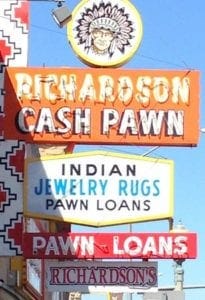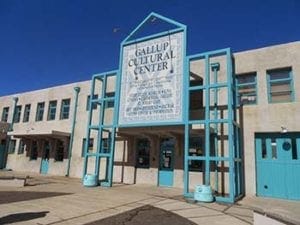Gallup, New Mexico — Cowboys & Indians, trains, hot-air balloons, neon
Sitting beside Interstate 40 about 125 miles west of Albuquerque, the town these days seems a bit out of the way. This is today's Wild West.
Gallup, New Mexico, is a city of throwbacks. Route 66 runs right through the town, with its left-over flickering neon-lit motels. About a hundred trains still rumble through town every day. The El Rancho Hotel stands open for business as it did in the days of John Wayne. Richardson's Trading Post flaunts authentic Navajo rugs, jewelry, guns and clothing, and acts as the pawn shop for locals as it has for about 100 years.
Sitting beside Interstate 40 about 125 miles west of Albuquerque, the town these days seems a bit out of the way. However, the road through El Morro was, once upon a time, one of the main wagon ways to the West. And later, with railroads and Route 66, Gallup was anything but off the beaten path.
Today, this dusty town surrounded by pine, juniper, and sandstone may not be a place to spend a week, but it certainly is a perfect hub for exploring western New Mexico, Navajo and Zuni reservations, Chaco Canyon to the north, and El Morro National Monument and El Malpais along a looping route to the south. Gallup is also a center for crowd-free hiking, biking, climbing, and ballooning.
Richardson's Trading Post
The Richardson family has been running this trading post for a century. It is an example of how the Indian economies interfaced with the outside world. The role of the trading post was far more than simply a general store, though it did serve that purpose as well. Trading posts were mini banks, pawn shops and economic engines of the towns and regions. These trading posts were places where local artisans and workers could leave articles on consignment for sale, trade their handicrafts for other items such as guns and clothing, and they served as a way to scrape together capital for new projects through pawning and borrowing.
The old railway station and Gallup Cultural Center
Gallup wouldn't be if it weren't for the railroad. If stories are to be believed, Gallup was named for David Gallup, a paymaster for the Atlantic and Pacific Railroad. The line, "I'm going to see Gallup," became so commonplace that folk assumed that was the town's name, not the paymaster. Over time, the name stuck to the town.
The Cultural Center has been developed on the second floor of the old stucco, Mission Revival railroad station. It displays contemporary Indian art in its Ceremonial Gallery. It includes the Storyteller Museum, a display of the WWII Navajo code breakers, a Visitor Center and the Kiva Cinema. In the summer, nightly Indian dances are performed at the Cultural Center.
This station was attached to one of the original Harvey Houses, El Navajo (title photo). These were upscale hotels and restaurants built in cooperation with the Santa Fe railroad. Think of them as a slightly more elegant chain of Howard Johnson hotel and restaurants of the Santa Fe rails. They came complete with what came to be called Harvey Girls.
It seemed that Fred Harvey learned that men were not terribly responsible in the days of the wild west, so he began hiring educated (the minimum was an 8th grade education) women to work at his chain of restaurants. At a time when it was claimed there were, "no ladies west of Dodge City and no women west of Albuquerque," the offer was a chance for adventure. Harvey Girls got good pay, uniforms, a place to sleep, board and a train ticket out west in return for a promise to behave and not get married for six months.
A movie starring Judy Garland was made about the Harvey Girls in 1946. It featured the Academy Award-winning song, "On the Atchison, Topeka and the Santa Fe."
El Rancho Hotel
All in all, staying at the El Rancho is a wonderful experience — not for any luxury (you won't find it), but for the Old West flavor from the spectacular lobby with its historic treasures to the glistening mirrored saloon bar.
Back in the 1940s and 1950s, Ronald Reagan, Humphrey Bogart, Spencer Tracy, Katharine Hepburn, Joan Crawford, Kirk Douglas and a host of other Western stars slept here while making movies on location in Gallup. The evocative hotel has rooms named for the stars that slept there.
The brother of the movie magnet D.W. Griffith owned the El Rancho, so this is where the stars and the crew would stay when shooting. Films made in Gallup included Billy the Kid (1930), Pursued (1947), The Sea of Grass (1947), Four Faces West (1948), Only the Valiant (1951), Ace in the Hole (1951), Escape from Fort Bravo (1953), A Distant Trumpet (1964) and The Hallelujah Trail (1965).
El Morro (a national monument to graffiti)
Though this spot seems to be somewhat off the main road, once upon a time it was one of the main watering holes for settlers on the way to California and armies conquering the region. The natural pool formed by snowmelt sits at the base of towering sheer cliffs that provided excellent shade as well as water.
The travelers who stopped at this oasis in the midst of parched land took water but also left a bit of history in the form of graffiti. Don Juan de Onate, the conquistador, left the earliest dated graffiti carved in the rocks sheltering the waterhole back in 1605. Later travelers stopped here with their armies while waging war against the Navajo Indians. Adventurers leading an experimental caravan of camels to California stopped as well. And, some graffiti artists seemed to enjoy creating ornate carvings with flourishes.
A self-guided trail leads visitors beside the east face of the mesa, past the water hole and past the many inscriptions. Another trail strikes off across the summit with spectacular vistas of surrounding mesas, forests, and plains. Amidst the "modern" graffiti, there are hundreds of Anasazi petroglyphs carved in the rocks long before the coming of the white man.
El Malpais National Monument
Where El Morro is a monument to graffiti, El Malpais is a monument of rugged remnants of swirling lava, cinder cones, caves (some with ice, some with bats), natural arches and spectacular views of sandstone bluffs and mesas. Don't worry; although El Malpais is considered an active volcano area, nothing has erupted here for around 2,000 to 3,000 years.
The easiest way to see the badlands, as they are called, is to drive down the eastern side of the lava flows. There are a couple of overlooks and eventually a nice natural bridge. Don't plan on finding anything to eat once you start the drive down the eastern side. If driving further west toward El Morro, stop to see the El Calderon and Big Tubes areas that includes 17 lava caves, lava vents and a bat cave complete with a swarm of circling bats in the evening as they head out for happy hunting at dusk.
Ballooning in Red Rock Canyon
Gallup is one of the ballooning capitals of New Mexico, ranking just after Albuquerque. On the first weekend of December there is a massive balloon festival.
Ballooning is a blast and a full morning adventure. It starts early when you and the balloon pilot pull the balloon and its basket out of the trailer and begin to set up the balloon. Then the gas burners are turned on and slowly the balloon begins to rise.
The flight brings the balloon basket almost scraping alongside the Red Rock Canyon walls and then the orb pops into the sun with endless views across the mesas and to Church Rock. Finally, the pilot will set the balloon back down in the next valley. You get to help pack the balloon and lift it into the trailer that followed the balloon on the ground to the landing spot.
It is one of those MasterCard moments — priceless and never forgotten.
If you are looking for a balloon ride, check in with Bill Lee, (505) 979-2012.
Eating Basics:
I can't vouch for it myself, but I have heard that Earl's, right on Rte. 66 (1400 E. Highway 66, 505-863-4201), serves up bountiful American vittles.
Badland's Grill (2201 West Highway 66, 505-722-5157) regularly gets great reviews from travelers and locals alike.
Jerry's Cafe (406 W Coal Ave, 505-722-6775) is great for families. Big sign outside and big portions inside.
Aurelia's Diner (2502 E. Highway 66) is a cute Rte. 66 diner with cutouts of stars to accompany you for your meal. The locals seem to love it and I've heard the Carne Adovada with homemade guacamole is worth the trip.
Vergie's Restaurant (2720 W. Hwy 66, 505-863-5152) is a local Mexican place with a good local crowd.
Finally, take time to test what has been called the best stuffed sopapilla in the world and solid New Mexican cuisine at Genaro’s Café (600 W Hill Ave, 505-863-6761). Tucked away, no booze, but great affordable food.
Photos: Lead photo of old postcard, other photos ©Leocha
Charlie Leocha
Charlie Leocha is the President of Travelers United. He has worked in Washington, DC, for the past 14 years with Congress, the Department of Transportation, and industry stakeholders on travel issues. He was the first consumer representative to the Advisory Committee for Aviation Consumer Protections appointed by the Secretary of Transportation from 2012 through 2018.












